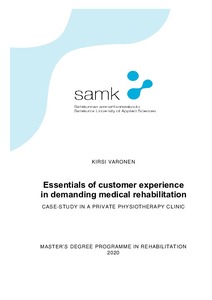Essentials of customer experience in demanding medical rehabilitation: Case-study in a private physiotherapy clinic.
Varonen, Kirsi (2020)
Varonen, Kirsi
2020
All rights reserved. This publication is copyrighted. You may download, display and print it for Your own personal use. Commercial use is prohibited.
Julkaisun pysyvä osoite on
https://urn.fi/URN:NBN:fi:amk-2020052212882
https://urn.fi/URN:NBN:fi:amk-2020052212882
Tiivistelmä
The objective of this qualitative case-study originated from the upcoming changes in the health care sector, where the customers’ freedom of choice will increase in the future. The role of customer experience as a competitive advantage will be noticeable. The purpose of this study was to deepen customer insight in the target organization. Customer experiences of Kela’s demanding medical rehabilitation customers were explored in relation to service encounters and touch point elements. This study was conducted as part of a wider development process of the target organization. A customer panel founded for developmental purposes acted as a focus group for the interviews. Two focus-group interviews with 4-7 customers were implemented within five months in 2019. Data was analyzed by using an abductive approach, where both theory and data guided the analysis of the data.
Different touch point elements as unique combinations affected the customer experience in several service encounters. The most critical service encounter was the actual physiotherapy appointment. This core service encounter was the most meaningful to customers and created the most value for them. The meanings linked to the core service were maintaining functioning, therapy creating structure to daily life, and social support. The role of people in creating a good customer experience was highlighted over any other touch point element. An especially important issue was the therapy relationship. Moreover, the continuity of therapy and person-centeredness concerning the content of therapy were important. Accessibility was the main factor affecting the customer experience when surroundings were concerned. These experiences were dependent on the customer’s functioning and changes in it over time. The customers’ need for advocacy and new experiences appeared in the experiences and in multiple suggestions for possible new service encounters.
Several managerial implications were presented to the target organization. Despite that the study was done as case study, these can be used more generally when developing customer-oriented rehabilitation services.
Different touch point elements as unique combinations affected the customer experience in several service encounters. The most critical service encounter was the actual physiotherapy appointment. This core service encounter was the most meaningful to customers and created the most value for them. The meanings linked to the core service were maintaining functioning, therapy creating structure to daily life, and social support. The role of people in creating a good customer experience was highlighted over any other touch point element. An especially important issue was the therapy relationship. Moreover, the continuity of therapy and person-centeredness concerning the content of therapy were important. Accessibility was the main factor affecting the customer experience when surroundings were concerned. These experiences were dependent on the customer’s functioning and changes in it over time. The customers’ need for advocacy and new experiences appeared in the experiences and in multiple suggestions for possible new service encounters.
Several managerial implications were presented to the target organization. Despite that the study was done as case study, these can be used more generally when developing customer-oriented rehabilitation services.
